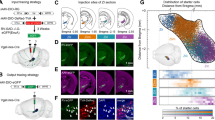Summary
-
1.
During mating, snails exhibit a marked suppression of the defensive withdrawal responses normally triggered by tactile contacts. Because previous work has identified the mesocerebrum as a center for the control of mating behavior, the present experiments tested whether the mesocerebrum can mediate the suppression of withdrawal responses.
-
2.
A group of large neurons was identified in the parietal ganglion as part of a command circuit for avoidance behavior, including withdrawal (Figs. 2–4).
-
3.
Extracellular stimulation of the mesocerebrum (20 Hz for 1–5 s) reduced the synaptic drive evoked in the parietal command neurons by a tactile stimulus (Fig. 5). In semi-intact preparations, there was a concurrent decrease in the number of action potentials evoked in the parietal cells and the extent of closure of the pneumostome, the latter being a measure of the behavioral response (Figs. 5 and 6).
-
4.
The mesocerebrum stimulus caused a hyperpolarization in parietal command neurons (Figs. 5 and 7). In addition, FMRFamide mediates an unidentified mechanism that contributes to the inhibition of evoked spiking in avoidance command cells (Figs. 9 and 10).
-
5.
In parallel with the foregoing, stimulation of the mesocerebrum inhibited a group of serotonergic neurons in the pedal ganglion that is capable of facilitating the afferent excitation of the avoidance command cells (Fig. 8).
Similar content being viewed by others
References
Adamo S, Chase R (1990) Courtship and copulation in the terrestrial snail Helix aspersa. Can J Zool 66:1446–1453
Adamo S, Chase R (1990) The ‘love dart’ of the snail Helix aspersa injects a pheromone that decreases courtship duration. J Exp Zool (in press)
Balaban PM (1979) A system of command neurons in snail's escape behavior. Acta Neurobiol Exp 39:97–107
Balaban PM (1983) Postsynaptic mechanism of withdrawal reflex sensitization in the snail. J Neurobiol 14:365–375
Balaban PM, Zakharov IS, Matz VN (1985) Method of vital selective staining of serotonergic nerve cells by 5,7-dihydroxytryptamine. Dokl Akad Nauk USSR 283:735–738 (in Russian)
Chase R (1986) Brain cells that command sexual behavior in the snail Helix aspersa. J Neurobiol 17:669–679
Davis NT (1982) Improved methods for cobalt filling and silver intensification of insect motor neurons. Stain Tech 57:239–244
Everett RA, Ostfeld RS, Davis WJ (1982) The behavioral hierarchy of the garden snail Helix aspersa. Z Tierpsychol 59:109–126
Gadotti D, Bauce LG, Lukowiak K, Bulloch A (1986) Transient depletion of serotonin in the nervous system of Helisoma. J Neurobiol 17:421–447
Kerkut GA, Lambert JDC, Gayton RJ, Loker JE, Walker RJ (1975) Mapping of nerve cells in the suboesophageal ganglia of Helix aspersa. Comp Biochem Physiol 50 A:1–25
Lukowiak K, Freedman L (1983) The gill withdrawal reflex is suppressed in sexually active Aplysia. Can J Physiol 61:743–748
Marchand C-R, Sokolove PG, Dubois MP (1984) Immunocytological localization of a somatostatin-like substance in the brain of the giant slug, Limax maximus L. Cell Tissue Res 238:349–353
Marchand C-R, Wijdenes J, Schot LPC (1982) Localisation par la technique cyto-immuno-enzymologique d'un neuropeptide cardio-exciteur (le F.M.R.F.-amide) dans le collier nerveux péri-oesophagien d'Hélix aspersa Müller. CR Acad Sci Paris 294:39–44
Maximova OA, Balaban PM (1983) Neural mechanisms of behavioral plasticity. Nauka, Moscow (in Russian)
Maximova OA, Balaban PM (1984) Neuronal correlates of aversive learning in command neurons for avoidance behavior of Helix lucorum L. Brain Res 292:139–149
Montarolo PG, Kandel ER, Schacher S (1988) Long-term heterosynaptic inhibition in Aplysia. Nature 333:171–174
Piomelli D, Volterra A, Dale N, Siegelbaum SA, Kandel ER, Schwartz JH, Belardetti F (1987) Lipoxygenase metabolites of arachidonic acid as second messengers for presynaptic inhibition of Aplysia sensory cells. Nature 328:38–43
Sakharov DA, Salánki J (1969) Physiological and morphological identification of neurons in the central nervous system of Helix pomatia L. Acta Physiol Acad Sci Hung 35:19–30
Tompa AS (1984) Land snails (Stylommatophora). In: Wilbur KM (ed) The Mollusca, vol 7, Reproduction. Academic Press, London, pp 47–140
Zakharov IS, Balaban PM, Chistyakova MV (1988) Role of serotonergic cells in aversive learning in Helix In: Salánki J (ed) Neurobiology of invertebrates, vol. 5. Akadémia Kiadó, Budapest, pp 519–530
Author information
Authors and Affiliations
Rights and permissions
About this article
Cite this article
Balaban, P., Chase, R. Stimulation of mesocerebrum in Helix aspersa inhibits the neural network underlying avoidance behavior. J Comp Physiol A 166, 421–427 (1990). https://doi.org/10.1007/BF00204816
Accepted:
Issue Date:
DOI: https://doi.org/10.1007/BF00204816




